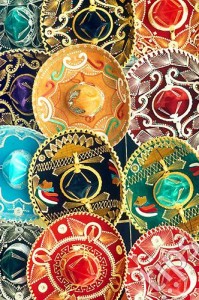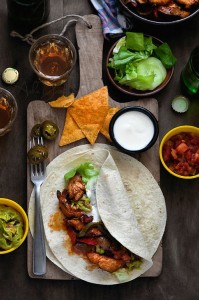-
Fiesta’s Highlights for 2013
- Starting the downstairs renovation for a fresh new look in 2014.
- Introducing new staff members to our team.
- Receiving the Top rated Mexican badge on Dimmi in 2013.
- Renovating the upstairs function area.
- Introducing churros to the food menu and offering more regional dishes.
- Seeing Andy Murray win the men’s Wimbledon Tennis.
- Joining the Twitter society.
- Seeing many celebrities and sports stars enjoying our food.
- Being mentioned in the Melbourne Official Visitor Guide and various Melbourne publications.
- Starting our Mexican Restaurant Blog.
We look forward to seeing you for a margarita in 2014!
Piñatas
The piñata was first recognised in Spain and then later brought to Mexico in the early 16thcentury. It was used to attract converts at their ceremonies. The piñatas were a clay pot decorated with feathers attached to a pole in a temple. It was seen as an offering to the feet of the god’s image when the treasures fell from the piñata. The treasures were released by the force of someone hitting the piñata with a stick.
The blindfold was later introduced by the Mayans. The piñata was also used “to attract converts to their religion.” They did not use feathers; instead, it was decorated with coloured paper. The Mayans believed the piñata was a symbol of the devil. Most piñatas were made with seven points to symbolise the “seven deadly sins, greed, gluttony, sloth, pride, envy, wrath and lust”. The treasures inside the piñatas were seen as a reward for keeping their religious faith.
Traditional Mexican piñatas are clay pots decorated with coloured paper, ribbon and tinsel. They were filled with lollies, confetti and fruit. They were used at birthday parties, fiestas and Christmas celebrations. Children would take turns at hitting the pinata with a stick as they sang the pinata song. “Dale, dale, no pierdas el tino, porque si lo pierdes, pierdes el camino” or in English “Hit it, hit it, hit it don’t let your aim go astray, because if you lose it, you lose your way.”
Once the piñata released its treasures the children rush in to collect as many lollies or fruit as they could.
Today the piñata is a symbol of entertainment and is used all around the world. At Fiesta our piñatas are colourful donkeys filled with delicious lollies awaiting to be released.
For more information about our functions visit http://www.fiestamexican.com.au/function.php
History Of The Sombrero
As you may already know a sombrero has a pointed crown in the middle with a large sixty-centimeter curved brim right around the crown, creating a shadow around the neck and shoulders.
Sombrero comes from the word “sombra”. In Spanish it means “shade” or “shadow” and is used for protection against the sun. Just like cowboy hats, they were used to represent social or economic status. The higher class men wore expensive sombreros made out of white, grey or tan felt with different designs and peasants wore cheaper sombreros made from straw.
 It was believed, the first sombrero was discovered in the 15th century. The first people to wear the sombrero hat were the Mestizo workers in Mexico and southern U.S. It was used as a practical hat to keep the sun away from their face. However, others believe it was the Guadalajara (horseback riders) who designed the hat as part of their uniform to represent “strength and power”.
It was believed, the first sombrero was discovered in the 15th century. The first people to wear the sombrero hat were the Mestizo workers in Mexico and southern U.S. It was used as a practical hat to keep the sun away from their face. However, others believe it was the Guadalajara (horseback riders) who designed the hat as part of their uniform to represent “strength and power”.
In current centuries the sombrero was associated with the cartoon character Speedy Gonzales, a Mexican mouse who wore a yellow sombrero.

The sombrero today is worn by mariachi band members, folk dancers and for traditional costumes. The beautiful colours and designs also make sombreros an ideal ornament as a symbol of Mexican historical culture simply placed on a decorative wall within the home.
Mexican Recipes
Have you ever wondered why Mexican food tastes so good? At Fiesta we offer an array of Mexican dishes. We cannot tell you our secret Mexican recipes but we can enlighten you on its history and our favourite Mexican food.
Our first favourite is the Burrito. Did you know the Burrito originated in a taco street stand in Mexico, by a man named Juan Mendez in 1910-1921? It is suggested he tried to find a way to keep his food warm for his taco street stand. In doing so he came up with the idea to wrap a homemade flour tortilla with a napkin.
Such a simple idea, right?
It was believed Juan Mendez’s food was a hit, in his local town. Burritos were then sold in areas of Northern Mexico using two main ingredients i.e. meat, beans, potatoes, chile rajas (green chilli & onion) or cheese in the burrito wrapped in a flour tortilla. In Mexico, the burrito was called “tacos de harina” or “flour wheat tacos”. At Fiesta we serve burrito especiales with main ingredients including poached chicken, frijole & corn, spicy beef or chilli con carne.
Another favourite classic Mexican dish of Fiesta is Fajitas. They are often associated with the idea of “make it yourself tacos” with ingredients used such as beef, vegetables, chicken or fish with onion and pepper cooked in a skillet. In Tex Mex terms fajita are referred to as “little strap”. This is because the steak used is carved into long and thin pieces.
In the 1950’s Mexican cowboys called “Vaqueros” ate skirt steak. The vaqueros experimented different ways in which they could cook or prepare the meat. Their favourite way was to marinate the steak in tequila or lime juice. They found this made the steak tender and was sliced across the grain to prevent it from becoming tough. However, it was not until later that the first Fajita was publicly revealed at the Boerne Bergestfest. After that, during the next 20 years, the world became a Fajita craze!
Our last favourite dish is Quesadillas or “little cheesy things”. This dish got its name from the Spanish word “queso” meaning cheese. A quesadilla is a tortilla that is filled with ingredients such as cheese, beans, potato, chicken or beef and is then folded over. After it has then been folded over it is heated on a griddle to ooze the melted cheese with the rest of the ingredients. In other words, it is a pretty fancy delicious Mexican toasted sandwich!
Now that you know the history of our favourite dishes you may be feeling a little bit hungry.
Oops!
Don’t forget to join us today to try our classic Mexican food.
We are open from 5 PM to late located in South Yarra, Victoria.
See you there!
Fiesta


